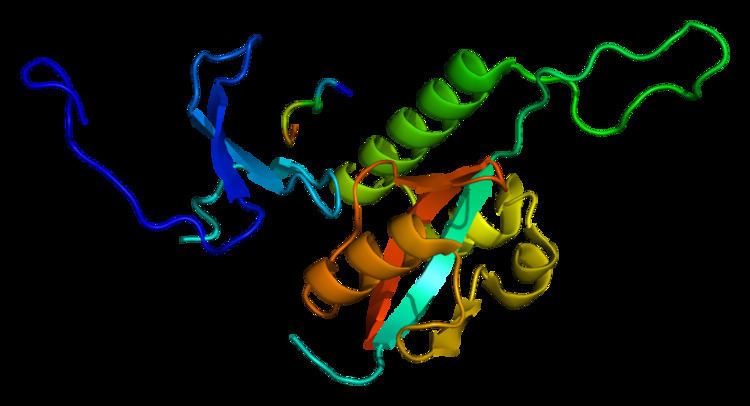Entrez 5300 | Ensembl ENSG00000127445 | |
 | ||
External IDs MGI: 1346036 HomoloGene: 4531 GeneCards: PIN1 | ||
Peptidyl-prolyl cis-trans isomerase NIMA-interacting 1 is an enzyme that in humans is encoded by the PIN1 gene. (Not to be confused with PIN1 (Pin-formed 1), an auxin transporter in Arabidopsis thaliana.)
Contents
Pin 1, or peptidyl-prolyl cis/trans isomerase (PPIase), isomerizes only phospho-Serine/Threonine-Proline motifs. The enzyme binds to a subset of proteins and thus plays a role as a post phosphorylation control in regulating protein function. Studies have shown that the deregulation of Pin1 may play a pivotal role in various diseases. Notably, the up-regulation of Pin1 may be implicated in certain cancers, and the down-regulation of Pin1 may be implicated in Alzheimer's disease. Inhibitors of Pin1 may have therapeutic implications for cancer and immune disorders.
Discovery
The gene encoding Pin1 was identified in 1996 as a result of a genetic/biochemical screen for proteins involved in mitotic regulation. It was found to be essential for cell division in some organisms. By 1999, however, it was apparent that Pin1 knockout mice had a surprisingly mild phenotype, indicating that the enzyme was not required for cell division per se. Further studies later found that loss of Pin1 in mice displays are not only neuronal degenerative phenotypes but also several abnormalities, similar to those of cyclin D1-null mice, suggesting the conformation changes mediated by Pin1 may be crucial for cell normal function.
Activation
Phosphorylation of Ser/Thr-Pro motifs in substrates is required for recognition by Pin1. Pin is a small protein at 18 kDa and does not have a nuclear localization or export signal. However, 2009, Lufei et al reported that Pin1 has putative novel nuclear localization signal (NLS) and Pin1 interacts with importin α5 (KPNA1). Substrate interactions and a WW domain determine subcellular distribution. Expression is induced by growth signals from E2F transcription factors. Expression levels fluctuate in normal, but not in cancerous cells. Expression is often associated with cell proliferation. Postranslational modifications such as phosphorylation on Ser16 inhibit the ability of Pin1 to bind substrate, and this inhibitory process may be altered during oncogenesis. It is hypothesized, but not proven, that Pin1 might also be regulated by proteolytic pathways.
Function
Pin1 activity regulates the outcome of proline-directed kinase (e.g. MAPK, CDK or GSK3) signalling and consequently regulates cell proliferation (in part through control of cyclin D1 levels and stability) and cell survival. The precise effects of Pin1 depend upon the system: Pin1 accelerates dephosphorylation of Cdc25 and Tau, but protects phosphorylated cyclin D from ubiquitination and proteolysis. Recent data also implicate Pin1 as playing an important role in immune responses, at least in part by increasing the stability of cytokine mRNAs by influencing the protein complexes to which they bind. A recent review by Kun Ping Lu attempts to provide a unifying framework for understanding Pin1 function by hypothesising that Pin1 acts as a molecular timer.
Interactions
PIN1 has been shown to interact with:
